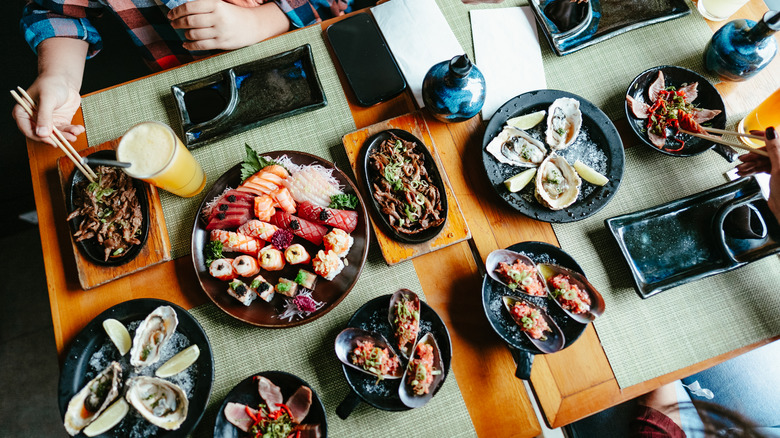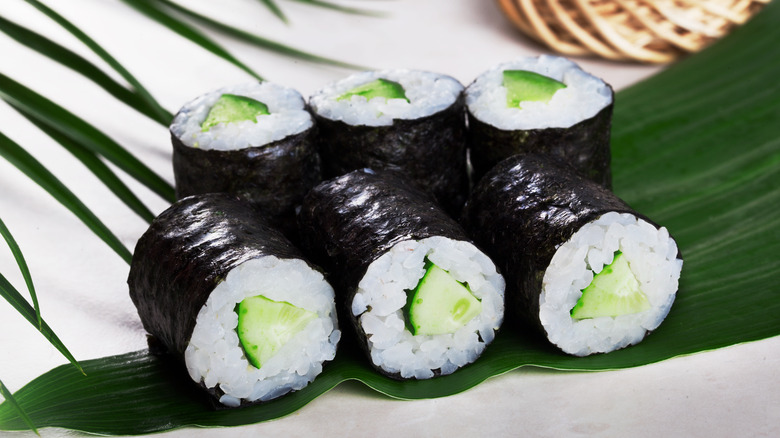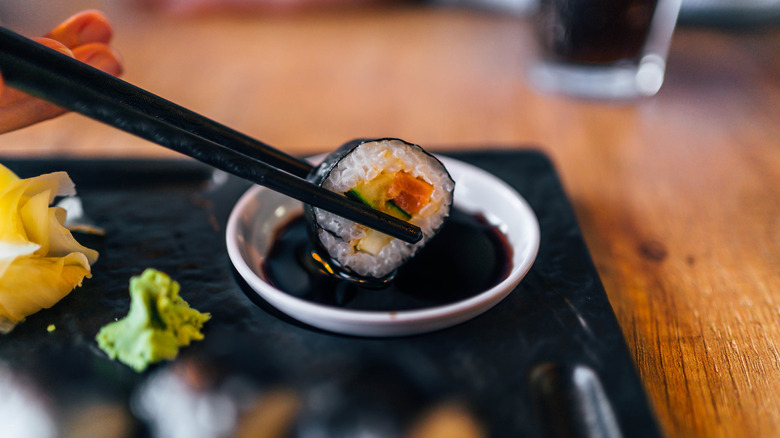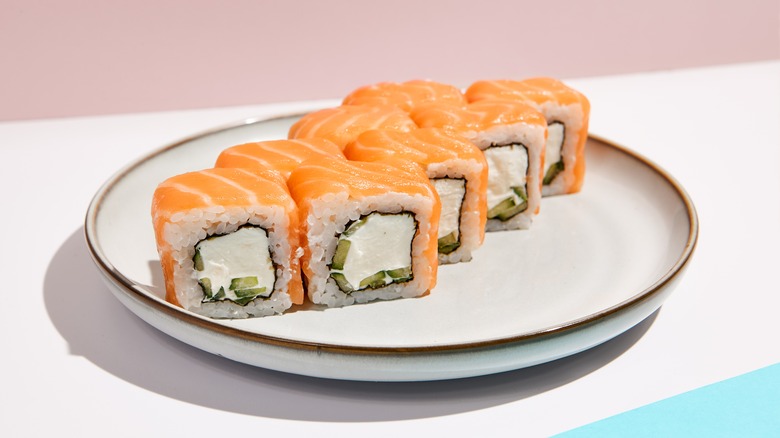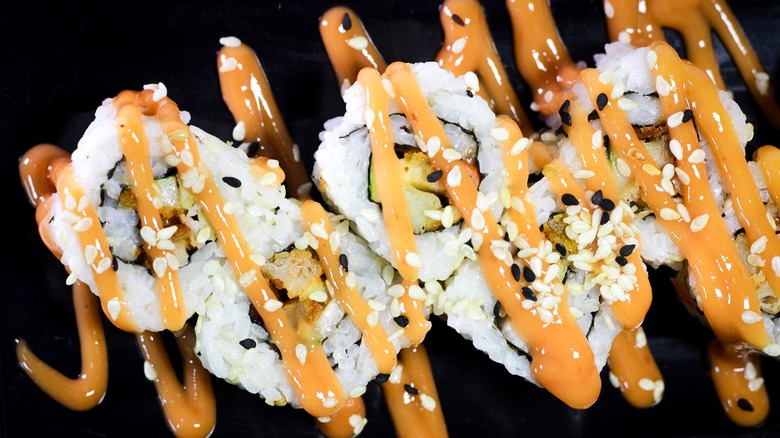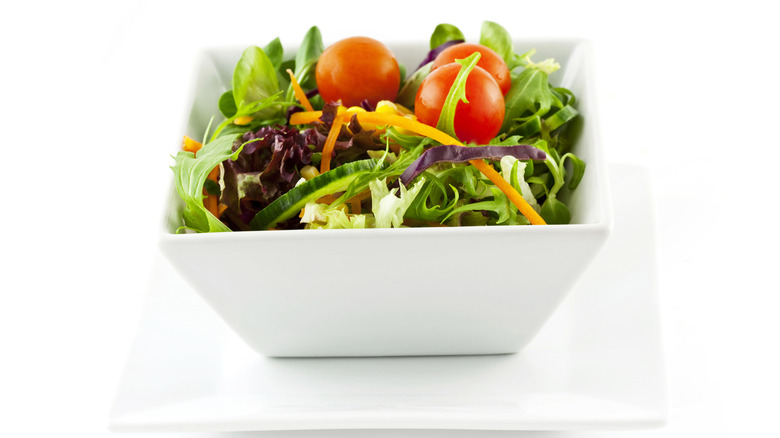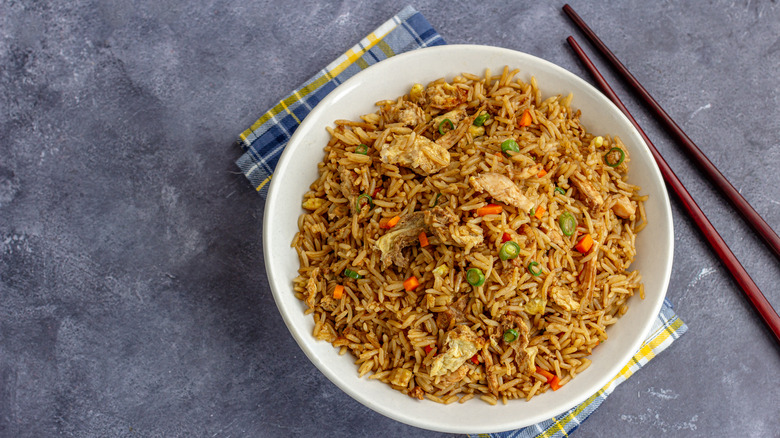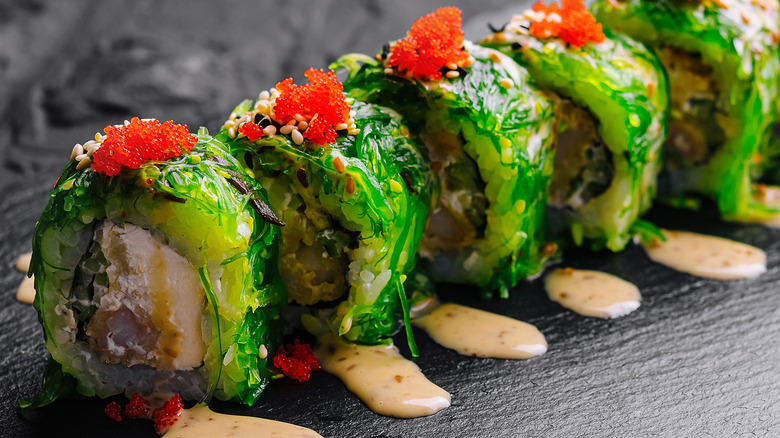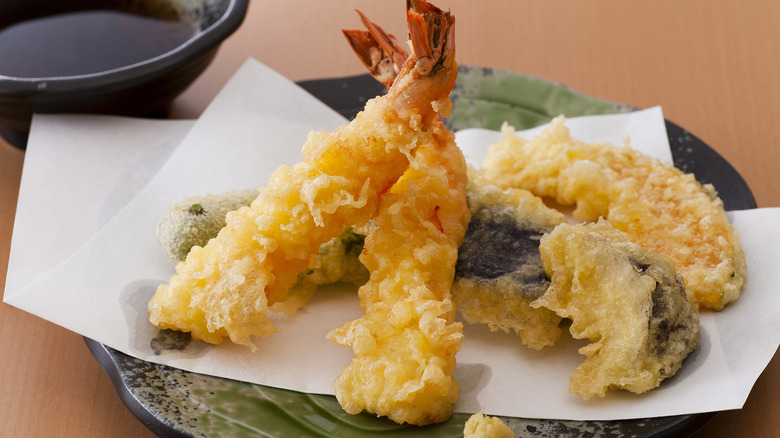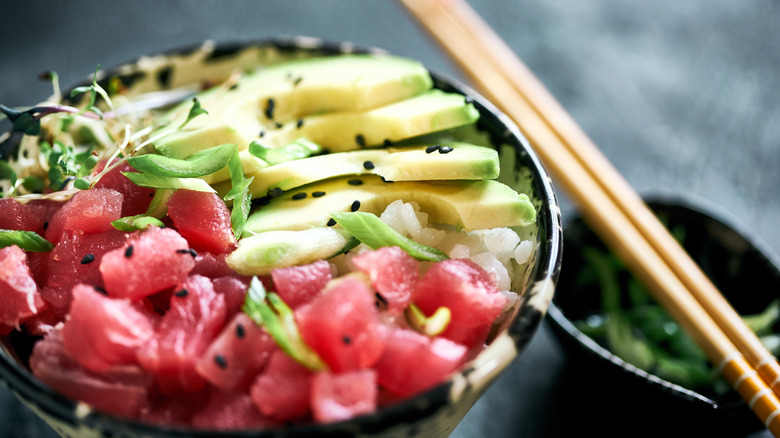9 Things You Should Reconsider Ordering From A Sushi Restaurant
When ordering at a sushi restaurant, you'd think your biggest concern is how to eat with chopsticks and do it effortlessly. Yes, those tricky wooden sticks can be difficult to operate if you've never used them before, but that's actually the least of your worries. Take a second look at the menu instead.
It might seem like nothing could possibly raise concern with the establishment's creatively named rolls and sea of gourmet-sounding appetizers, chiefly when the chefs are often preparing the food right in plain sight. But there's a reason to think twice about certain items, whether it's due to eye-raising nutritional value, deviation from authentic Japanese cuisine, or simply having better options to choose from. And while there's rarely a bad choice when it comes to sushi restaurants, it might surprise you that there are some fan-favorite orders, such as Philadelphia rolls or late night specials, that are worth reconsidering.
Veggie rolls
How could this list possibly start off with such a harmless option? Veggie rolls make are great go-to orders for vegans and vegetarians. They're among the healthiest you can get when thanks to being filled with superfoods like avocado and cucumber.
While veggie rolls can be an easy way to get in your vitamins and minerals, they can sometimes lack flavor. This is mainly the case if the roll is made with only one main ingredient. Consider searching for complex veggie rolls that contain multiple elements in order to reap your nutrients while still enjoying a more elaborate flavor. That can mean picking a rainbow veggie roll, filled with mango, cucumber, sweet peppers, carrots, and avocados. Alternatively, if non-vegan options are allowed in your diet, try pushing yourself out of your comfort zone by going for a completely different type of sushi than you might be used to. Drop the Kappa Maki, and try out a Tako roll or Iwashi roll, for instance.
Extra sauces
What can make some sushi so attractive to both the eyes and the tastebuds is the generous use of sauce. By way of visualization, spicy mayo not only adds a little kick to the roll's flavor, but also a drizzle of that infamous light orange hue brightens your food's aesthetic. Eel sauce and teriyaki sauce can do the same, providing a sweet taste that also has your sushi looking more complex and upscale.
These condiments can make all the difference in how your order turns out, for better or worse. The result leans toward the latter when sauce is excessively used. Soy sauce is a prime example of this. Sushi-lovers know how it feels to dunk your nigiri in the savory liquid only for the rice to break apart and crumble into the soy sauce. Suddenly, you're left with half the amount of rice you started with and a sauce dish with floating rice grains. Not to mention, your fish now tastes extra salty.
This is a case in point of how using too much of a condiment can detract from the taste of your protein. In fact, one of the tips for eating sushi, according to a pro, is that sometimes you don't need any sauce at all. In some restaurants, the nigiri is already constructed with small touches of soy sauce and wasabi before being served. Shingo Akikuni, a sushi chef who works at SHINGO, a Japanese restaurant in Miami, Florida, suggests that diners who choose to use additional sauce should do it very lightly and only use the edge of the fish.
Philadelphia rolls
Philadelphia rolls might not have the excessive sauce you've been warned about, but you should be wary of its other contents. As the name gives away, the roll was inspired by Philadelphia's own cream cheese brand, creating a blend between Western and Japanese influences as it incorporates cucumber and either smoked or raw salmon. The Philadelphia roll quickly found its way to sushi restaurants around the country when the roll was first introduced in the city of Brotherly Love in 1983. It's a wonderful and delicious intertwining of two cultures, but the large amount of cream cheese is worth debating.
Cream cheese is a heavy, filling ingredient that can overpower other parts of the roll, including the protein that largely dictates the price you're paying. The dairy may also leave behind a thick coating in your mouth that can stick around longer than you'd like it to, similar to the way chocolate or ice cream does. That's why these items are hailed as desserts, so that the leftover film of dairy doesn't impact the foods to follow. The Philadelphia roll can be an entree or appetizer, so consider how it might affect the rest of your meal.
Spicy foods
People who love spice have come to understand the shared desire of wanting a little bit of heat on almost everything they eat. Otherwise, the meal just feels incomplete. The food at a sushi restaurant is no exception to this craving, and sushi chefs have catered to this whim, offering customers everything from spicy salmon tartare to spicy tuna rolls. The selections are often made with wasabi, the hot green paste people either hate or love, or mayonnaise mixed with hot sauce.
The only drawback to ordering these items is that they will alter your taste buds for the rest of your dining experience. Capsaicin, the chili pepper extract found in spicy food, is an active ingredient that clings to your mouth and imitates the feeling of heat. The fiery feeling lingers for so long because capsaicin is slow to dissolve and isn't easily broken down by water like other food components. Your tongue might still feel a bit of heat even when you're far past your spicy crab roll, affecting how you experience the rest of your food. So if you're determined to eat something spicy while you're out, try to save it for the end, or be sure to eat ginger between bites to cleanse your palate.
Mixed greens salad
From fried calamari to miso soup, appetizers can make or break someone's experience at a sushi restaurant. Those who are avid all-you-can-eat sushi goers can especially understand this important criteria, as sometimes they make their way out the house just to have several orders of their favorite starters. Seeing them missing from the menu can be utterly disappointing. But one appetizer that never seems to get left out is the classic side salad. It's almost always there for people who want to make sure they get their daily helping of greens and veggies.
Consider opting for a seaweed salad instead, though. You can still get your greens in by ordering this item. Typically made from a popular type of seaweed called wakame, this appetizer is frequently served at Japanese restaurants and will provide you with a more authentic cultural experience. Though premade versions tend to contain a few unnecessary ingredients, the dish still has many health benefits overall. This includes high fiber and iodine content as well as a notable amount of manganese and folate.
Fried rice
Ordering fried rice at a sushi restaurant is like ordering chicken nuggets at an establishment that excels at making gourmet pasta. There's nothing wrong with it, but you just aren't reaping the opportunity to try what the place actually specializes in. The sushi on the menu, from hand rolls and maki rolls to nigiri and sashimi, are just waiting to be eaten. And if you order something as filling as fried rice, the heavy ingredients and carbs may lessen your appetite when it comes time to experience the sushi you actually came for.
That's not to say that fried rice isn't understandably comforting and certainly a crowd-pleaser. But because it's not what sushi restaurants are particularly skilled at making, you're likely to find it at another place that might cook it even better. You can even make the perfect fried rice right at home.
Tobiko
What is tobiko, you ask? No, it's not the type of egg you'd use for a ham and feta egg white bites recipe. It's flying fish roe, another name for the satisfyingly crunchy, bright-colored fish eggs that are used as a topping for sushi such as shrimp tempura and California rolls. With an exotically alluring description like that, along with their eye-catching appearance and fun texture, it may seem silly not to order something that uses such a delicacy. And while it can be considered a luxurious item at sushi restaurants and is at times even used as a more affordable form of caviar, they should be consumed in moderation.
This is because tobiko is very high in cholesterol. A one tablespoon portion of the small eggs contains 90 milligrams, which is already 30% of the suggested daily value. Tobiko is also high in sodium, coming in at 225 milligrams, or 10% of the recommended salt intake. These numbers are nothing to worry about so long as you control how much of it you eat, especially if it's only lightly sprinkled on your sushi of choice. But for those closely watching their diet, steer clear of eating too many tobiko rolls at one time.
Tempura
Chicken and shrimp tempura rolls have become among the most popular types of sushi. They're two of the safest options for those yet to venture into the raw side of fish. Not to mention, the crispy, slightly sweet quality of the fried batter coating adds to their appeal. It's why even vegetable tempura has been put on the map. It makes sense to order these when the place you're buying it from is able to make it to perfection.
But as the trend goes, that's not always the case, and deep frying can be done with oil that's actually not up to code. It might not be replaced or filtered as regularly as needed to give your tempura the appropriate flavor. The use of too much oil, particularly of a lower-quality kind, can also make your food unnecessarily fatty and heavy. You'll get full from the tempura before you even get the chance to try lighter, finer options like sashimi. If you've really got a hankering for the deep-fried stuff, though, consider making tempura at home where you can control both the amount and type of oil.
Daily specials
Food always hits better when you get it at a discounted price. Nothing beats having to pay less for a meal you've been craving all week or a new-sounding recipe advertised on the eatery's chalkboard. This is largely relatable when it comes to a sushi restaurant where the bill racks up easily as you order roll after roll. It may seem like a no-brainer to take advantage of daily specials for this very reason. But sometimes, there's a catch, and restaurants are promoting these items with a hidden agenda.
The concept of daily specials, whether offered throughout the day or just at night, gives restaurants the chance to throw together older ingredients and make a dish out of it. The establishment publicizes these side dishes (or sushi rolls) as though they're doing you a favor by offering a cheaper item that isn't always available. What they don't tell you is that it might be made using less desirable parts of the fish or perhaps even ingredients that might spoil if they not used quickly enough.
Use caution when ordering specials like salads with bits of sashimi thrown in. You never know if the restaurant is trying to unload leftovers. If you're not careful, eating spoiled fish can have a plethora of bad side effects. That includes but is not limited to fatigue, vomiting, and diarrhea. You may also experience tingling in your mouth and extreme itchiness, among other issues.
